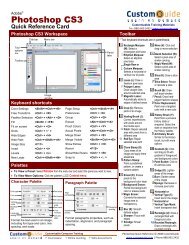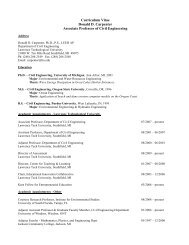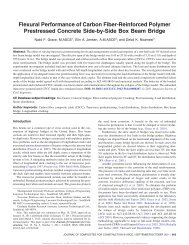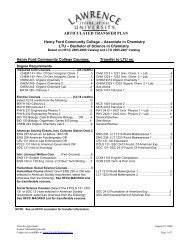Exhibition Catalog - Lawrence Technological University
Exhibition Catalog - Lawrence Technological University
Exhibition Catalog - Lawrence Technological University
You also want an ePaper? Increase the reach of your titles
YUMPU automatically turns print PDFs into web optimized ePapers that Google loves.
evealing, inaccurate, but compelling book” about<br />
Wright’s life and philosophy. 8 An Autobiography was<br />
reviewed and praised in many leading journals. The<br />
second book, The Disappearing City, was Wright’s tirade<br />
against urbanization; it contained his first discussion<br />
of Broadacre City, the agrarian utopia that he<br />
intended as the replacement for the modern city.<br />
3<br />
In the next five years, Wright reemerged on the national<br />
architectural scene with such renowned designs<br />
as the Kaufmann “Fallingwater” House (1935),<br />
the Jacobs House (1936), the Johnson Wax Administration<br />
Building (1936), and his second home, Taliesin<br />
West (1937). His star shone brighter than ever, and<br />
more commissions began to arrive at Taliesin. Wright<br />
appeared on the cover of Time in January, 1938,<br />
and in nearly thirty articles during that year, from<br />
such popular fare as Life and The New Yorker to a remarkable<br />
special issue of Architectural Forum (also in<br />
January) devoted entirely to his architecture. 9 And<br />
the Museum of Modern Art in New York opened an<br />
exhibition on Fallingwater in January, the first time<br />
that institution ever held a major one-building exhibit<br />
on a living architect. Wright would continue to work<br />
on a seemingly endless stream of compositions until<br />
his death in 1959 at the age of ninety-one.<br />
Usonian Houses<br />
The major project of the last two decades of Frank<br />
Lloyd Wright’s life was the creation and promotion<br />
of “Usonian” houses. Wright conceived the Usonian<br />
project as an extension of the principles first developed<br />
in his Prairie-style houses of the 1900s-1910s.<br />
“Usonia” was a word coined by Wright to represent<br />
“The United States of America” – inspired by his perception<br />
that the moniker “America” was too vague,<br />
arguably including countries beyond the U.S.A. His<br />
intention was to build on the basic elements of the<br />
Prairie houses – natural materials, harmony with nature,<br />
open plans, and a uniquely American idiom<br />
– by utilizing mass production technology to produce<br />
affordable single-family housing for all socioeconomic<br />
classes. The Usonians would achieve their<br />
inexpensiveness through prefabricated parts, paring<br />
the house down to basics, and using a new method<br />
for constructing walls. Conceived as an antidote to<br />
the social and economic realities of the Great Depression,<br />
eighteen Usonian houses were built between<br />
1939 and 1941; the Usonian program eventually<br />
produced over 100 houses before Wright’s death<br />
in 1959.<br />
Wright was not alone in turning to mass production as<br />
a means to stimulate housing construction during the<br />
Depression. Although prefabricated housing dates<br />
back to the nineteenth century, conditions in Europe<br />
after World War I, and around the world in the thirties,<br />
drove architects of all persuasions to tackle the<br />
challenge of designing cost-efficient houses, leading<br />
Photograph by Balthazar Korab

















